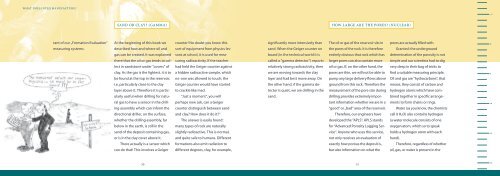BAKER HUGHES
You also want an ePaper? Increase the reach of your titles
YUMPU automatically turns print PDFs into web optimized ePapers that Google loves.
W H AT DOE S I N TEQ M A N U FACTUR E ?<br />
– 5<br />
Sa nd or Cl ay ? (Ga mma)<br />
How l a rge a r e the Por es ? (Nuclear)<br />
tant of our „Formation Evaluation“<br />
measuring systems.<br />
At the beginning of this book we<br />
described how and where oil and<br />
gas can be created. It was explained<br />
there that the oil or gas tends to collect<br />
in sandstone under “covers” of<br />
clay. As the gas is the lightest, it is to<br />
be found at the top in the reservoir,<br />
i.e. particularly close to the clay<br />
layer above it. Therefore it is particularly<br />
useful when drilling for natural<br />
gas to have a sensor in the drilling<br />
assembly which can inform the<br />
directional driller, on the surface,<br />
whether the drilling assembly, far<br />
below in the earth, is still in the<br />
sand of the deposit containing gas,<br />
or is in the clay cover above it.<br />
There actually is a sensor which<br />
can do that! This involves a Geiger<br />
counter! No doubt you know this<br />
sort of equipment from physics lessons<br />
at school, it is used for measuring<br />
radioactivity. If the teacher<br />
had held the Geiger counter against<br />
a hidden radioactive sample, which<br />
no-one was allowed to touch, the<br />
Geiger counter would have started<br />
to crackle like mad.<br />
“Just a moment“, you will<br />
perhaps now ask, can a Geiger<br />
counter distinguish between sand<br />
and clay? How does it do it?“<br />
The answer is easily found:<br />
many types of rock are naturally<br />
slightly radioactive. This is normal,<br />
and quite safe to humans. Different<br />
formations also emit radiation to<br />
different degrees, clay, for example,<br />
significantly more intensively than<br />
sand. When the Geiger counter on<br />
board (in the technical world it is<br />
called a “gamma detector“) reports<br />
relatively strong radioactivity, then<br />
we are moving towards the clay<br />
layer and had best move away. On<br />
the other hand, if the gamma detector<br />
is quiet, we are drilling in the<br />
sand.<br />
The oil or gas of the reservoir sits in<br />
the pores of the rock. It is therefore<br />
entirely obvious that rock which has<br />
larger pores can also contain more<br />
oil or gas. If, on the other hand, the<br />
pores are thin, we will not be able to<br />
pump any large delivery flows above<br />
ground from this rock. Therefore the<br />
measurement of the pore size during<br />
drilling provides extremely important<br />
information whether we are in a<br />
“good“ or „bad“ area of the reservoir.<br />
Therefore, our engineers have<br />
developed the “APLS“. APLS stands<br />
for “Advanced Porosity Logging Service“.<br />
Anyone who uses this service,<br />
not only receives an evaluation of<br />
exactly how porous the deposit is,<br />
but also information on what the<br />
pores are actually filled with.<br />
Granted: the underground<br />
determination of the porosity is not<br />
simple and our scientists had to dig<br />
very deep in their bag of tricks to<br />
find a suitable measuring principle.<br />
Oil and gas are “hydrocarbons”, that<br />
means, they consist of carbon and<br />
hydrogen atoms which have combined<br />
together in specific arrangements<br />
to form chains or rings.<br />
Water (as you know, the chemists<br />
call it H 2 O) also contains hydrogen<br />
(a water molecule consists of one<br />
oxygen atom, which so to speak<br />
holds a hydrogen atom with each<br />
hand).<br />
Therefore, regardless of whether<br />
oil, gas, or water is present in the<br />
0<br />
5<br />
10<br />
15<br />
50<br />
51<br />
20



